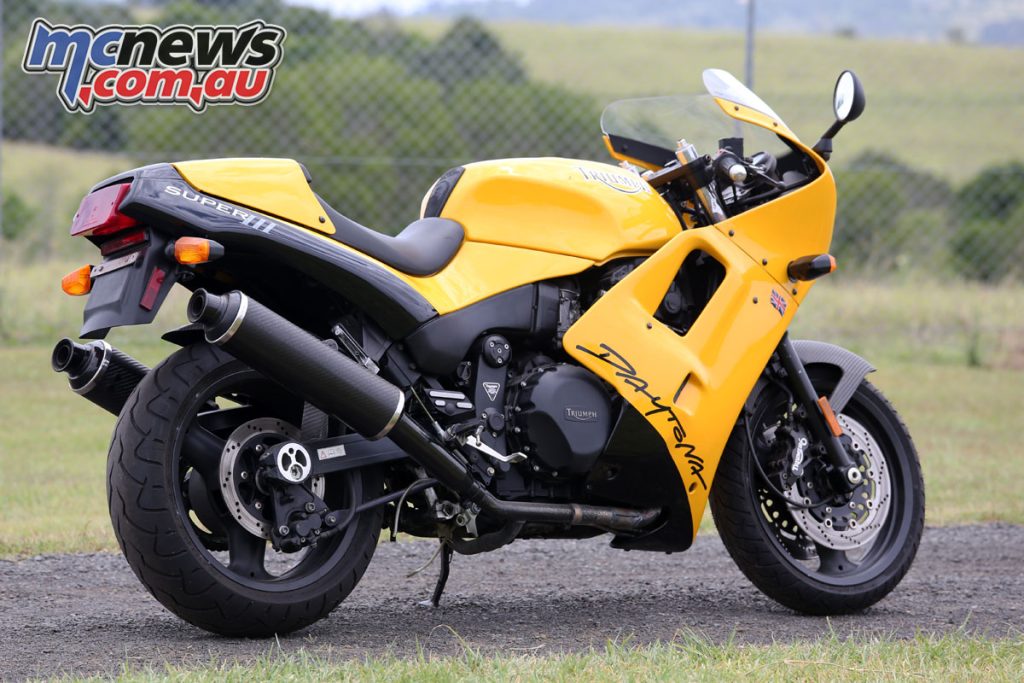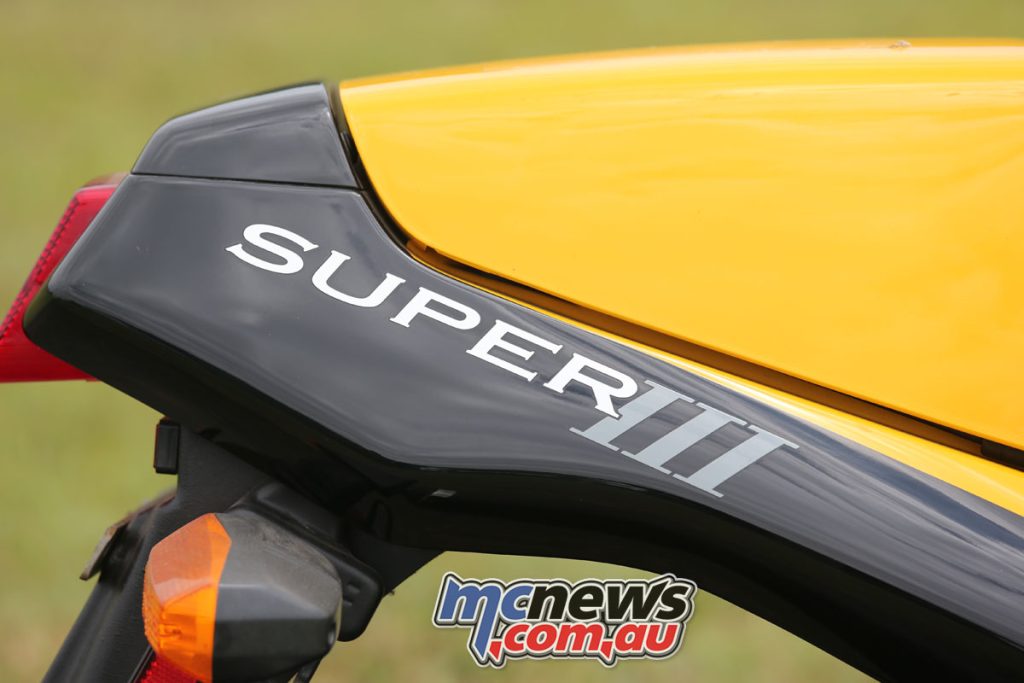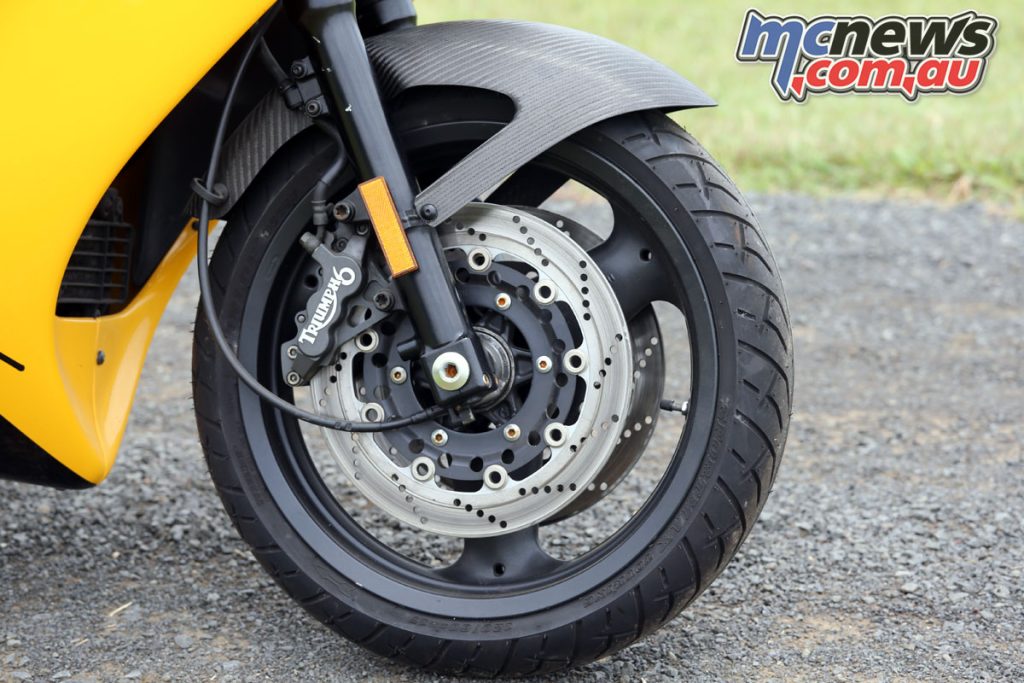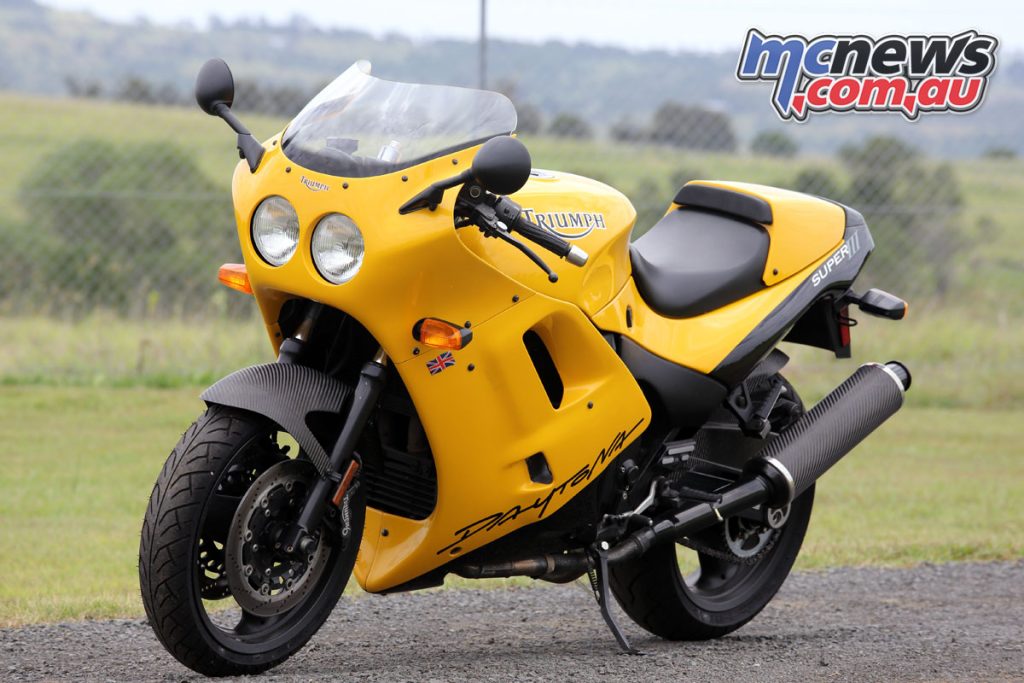Triumph Daytona Super III
With Ian Falloon
After acquiring Triumph’s name and rights in 1983, and subsequently leasing these to Les Harris, John Bloor quietly set about designing a new range of motorcycles that bore no relationship to the previous Bonneville. The Triumph Super III as pictured here was perhaps the most special model to come from the first Hinckley generation.

Determined not to repeat the series of “false dawns” that had epitomised many British motorcycle industry revivals (notably Hesketh and Norton), Bloor set up a research and development unit, and began looking for a suitable factory site. It soon became evident that Bloor’s business philosophy differed substantially to Edward Turner’s earlier model that had characterised Triumph in the previous era.
Rather than pursue immediate short-term profits with underdeveloped products, Bloor sanctioned all-new designs, underwriting the development costs for several years. Although the Triumph name was well respected, it also came with some baggage, particularly in regard to electrical and general reliability.
Bloor thus decided on a conservative approach, promoting the new range as modern, not retro, and launching Triumph as small high-quality producer with the intention of eventually growing into a large volume mainstream manufacturer, competing directly with the Japanese.
In 1988 Bloor purchased a 10-acre site in Hinckley, Leicestershire and proceeded to build a 150,000 square-foot modern factory, known as T1. The factory opened in 1990, with about one third of components manufactured in-house to ensure superior quality control.

Triumph’s renaissance was shrouded in mystery, and when Triumph displayed the new range to the press on June 29, 1990, journalists were stunned. Privately financed to the tune of £80 million, Bloor had built the state-of-the-art plant and developed the bikes in secret. After launching the initial range of pre-production models at the Cologne Show in September, a six-model line-up was displayed in December at the NEC in Birmingham, with production scheduled for the 1991 Model Year.
The new engine design was arguably Kawasaki-influenced and emphasised durability. The valves were operated by twin overhead camshafts running directly in the head, these driven by a Hy-Vo chain on the right side of the engine. The cylinder head design was the same for all engines, with two 32 mm inlet valves and two 28 mm exhaust valves inclined at 39 degrees.
Valve adjustment was by bucket and shim, and a one-piece crank shaft was coupled to balancer shafts, one for the triples and two for the fours. An example of Triumph’s quest for reliability was the crankshaft manufacturing process, the crankshaft heat-treated for 30 hours in a plasma nitride furnace and machined to tolerances of five microns.
The horizontally-split crankcase included a wet-liner block, and as all engines shared the same mounting points the frames and fuel tanks were interchangeable between all models. The spine frame and aluminium swingarms were also manufactured on a robotic production line in-house, the swingarm MIG instead of TIG welded to minimise distortion.

With no UK-based suspension or carburettor suppliers left, Kayaba supplied the front forks and the shock, Shin Nippon the wheels, and Mikuni the carburettors. Emphasis was placed on build quality, each machine undergoing a cold engine test, culminating in a rolling road analysis, and resulting in a range of British motorcycles with genuine character. Practicality was also a priority, with major service intervals at 6,000 miles and only eleven service items across the entire range.
Production commenced in February 1991, initially only a modest five bikes a day, this increasing significantly in 1992 and 1993. Triumph was also determined to create a real sports bike out of the spine-frame Daytona, and the Daytona Super III appeared during 1994.
The 885cc Super III engine shared the updated Daytona’s long-stroke dimensions of 76 x 65 mm and included new cylinder heads and crankcases designed by Cosworth Engineering in Worcester. Cosworth also helped develop new high lift camshafts, and a gas-flowed cylinder head. With higher compression 12:1 pistons, a bank of three Mikuni BST 36mm flat slide CV carburettors and exhaust updates the power was increased 15 per cent over the standard Daytona 900, to 115 horsepower at 9,500 rpm.
The spine frame was the usual type Daytona, constructed of high-tensile 600MPa micro-alloyed steel, while the aluminium swingarm included eccentric chain adjustment. The front fork was a conventional 43 mm adjustable telescopic type, with adjustable Monoshock rear suspension.

Along with carbon-fibre mudguards and silencers, the Super III was the first Triumph with new Alcon-produced six-piston brake calipers, these radically improving the braking performance. Alcon specialised in Indy car braking systems. The discs were twin 310 mm on the front and 255 mm on the rear.
As on all Daytonas this year a pair of 17-inch three-spoke Brembo wheels replaced the six-spoke type. These had hollow spokes and wider rims, and a rear wheel hugger incorporated the chain guard. Although the new crankcases and carbon-fibre components saved around 5 kg, the 211 kg Super III was still much heavier than comparable Japanese Superbikes, notably the 185 kg Honda Fireblade.
The Super III was also extremely expensive at the time and continued basically unchanged for 1995, with another 300 produced. 1996 was the last year for the spine frame Triumph and the Super III received a lighter Nitrogen-charged rear shock absorber, and a shorter re-valved Kayaba front fork that sat flush in the top triple clamp.
The brake calipers were gold rather than black, and this year the Super III was only available in a limited number of 150. Super III total production over three years was only 805, and while not the most contemporary sports bike, it provided a foundation for the next sporting Daytona.
Towards the end of 1996 Hinckley’s initial renaissance came to an end. Successfully launched utilising an economically expedient modular approach, the time had come for more pragmatic modus. In an age of increased specialisation and extremely competent competition, the strong, effective, but heavy spine frame had its limitations, particularly for a sports bike. While the spine frame models would overlap for a few more years, Hinckley’s next episode would embrace new tubular aluminium frames and fuel-injected engines.
Triumph Daytona Super III Specifications
- Engine – Liquid-cooled, four-stroke, transverse triple, DOHC
- Capacity – 885 cc
- Bore x Stroke – 76 x 65 mm
- Compression Ratio – 12.0:1
- Induction – 3 x Mikuni BST36 Flat-Slide CV
- Claimed Power – 115 hp at 9500 rpm
- Claimed Torque – 89 Nm at 8500 rpm
- Gearbox – Six speed
- Clutch – Wet, multi-plate
- Final Drive – Chain
- Frame – High-tensile steel
- Rims – 17×3.5″ (F), 17 x 5.5″ (R)
- Tyres – 120/70-17 (F), 180/55-17 (R)
- Front Suspension – 43 mm forks, triple rate springs, fully adjustable, 150 mm travel
- Rear Suspension – Monoshock, adjust pre-load/rebound, 126 mm travel
- Front Brakes – 2 x 310 mm float discs, six-piston calipers
- Rear Brake – 255 mm disc, two-piston caliper
- L x W x H – 2151 x 690 x 1185 mm
- Wheelbase – 1491 mm
- Rake / Trail – 27-degrees / 105 mm
- Seat Height – 790 mm
- Ground Clearance – 138 mm
- Dry Weight – 211 kg
- Kerb Weight – 245 kg
- Fuel Capacity – 25 litres























